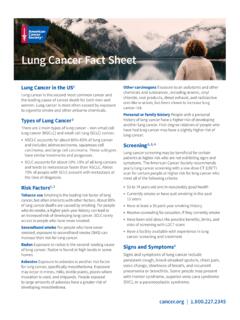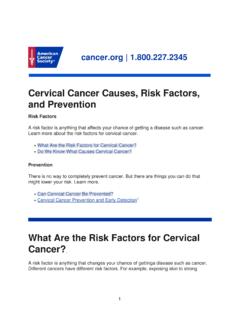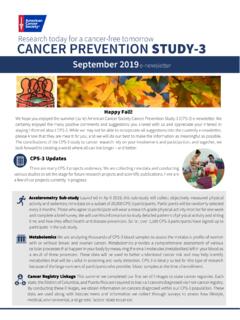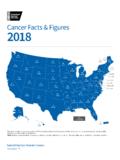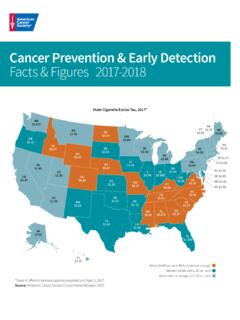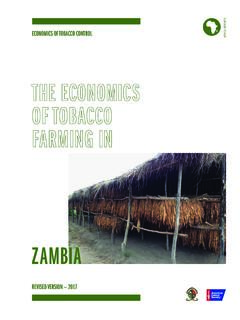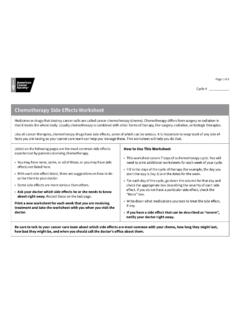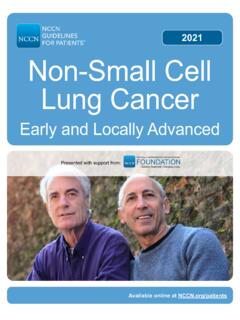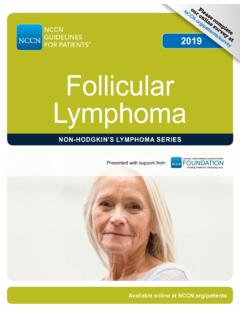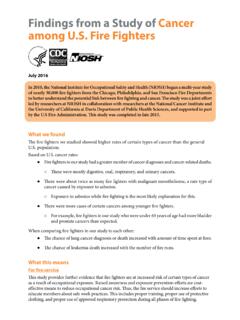Transcription of Colorectal Cancer Facts & Figures 2020-2022
1 AL70AZ67AR67CA73CO69CT 75DE 73FL71GA70ID67IL67IN68IA71KS68KY70LA70ME 75MD 73MA76MN73MS64MO69MT65NE68NV62NH75NJ 68NM63NY70NC71ND67OH68OK64OR72PA70RI 75SC72SD69TN70TX62UT69VT71VA70WA72WV68WI 74WY60DC 74HI73AK62MI74*Blood stool test, sigmoidoscopy, or colonoscopy in the past 1, 5, and 10 years, respectively. Note: Estimates are age adjusted to the 2000 US standard population and do not distinguish between examinations for screening and : Behavioral Risk Factors Surveillance System, 2018. See Sources of Statistics (page 32) for complete citation and more information. Colorectal Cancer screening Test Use* (%), Adults 50 Years and Older by State, 2018PR5858% to 64%65% to 69%70% to 72%73% to 76% Colorectal CancerFacts & Figures 2020-2022 (page 32)ContentsColorectal Cancer Basic Facts 1 Figure 1. Anatomy of the Gastrointestinal System 1 Figure 2. Stages of Colorectal Cancer Growth 2 Colorectal Cancer Occurrence 3 Table 1. Estimated Number of Colorectal Cancer Cases and Deaths in the US in 2020 by Age 3 Figure 3.
2 Colorectal Cancer Incidence (2012-2016) and Mortality (2013-2017) Rates by Subsite and Sex, US 4 Figure 4. Age-specific Colorectal Cancer Incidence Rates, US, 2012-2016 4 Figure 5. Colorectal Cancer Incidence (2012-2016) and Mortality (2013-2017) Rates by Race/Ethnicity and Sex, US 5 Figure 6. Trends in Colorectal Cancer Incidence (1975-2016) and Mortality (1930-2017) Rates by Sex, US 6 Figure 7. Trends in Colorectal Cancer Incidence (1995-2016) and Mortality (1970-2017) Rates by Age and Sex, US 7 Figure 8. Trends in Colorectal Cancer Incidence (1975-2016) and Mortality (1970-2017) Rates by Race, US 8 Figure 9. Colorectal Cancer Incidence (2012-2016) and Mortality (2013-2017) Rates by State, US 9 Table 2. Colorectal Cancer Incidence (2012-2016) and Mortality (2013-2017) Rates by Race/Ethnicity and State, US 10 Figure 10. Colorectal Cancer Five-year Survival (%) by Age and Race/Ethnicity, 2009-2015 11 Figure 11.
3 Colorectal Cancer Stage Distribution (%) by Age and Race/Ethnicity, 2012-2016 12 Colorectal Cancer Risk Factors 13 Table 3. Relative Risks for Established Colorectal Cancer Risk Factors 13 Colorectal Cancer screening 18 Table 4. Characteristics of Recommended Colorectal Cancer screening Tests 20 Table 5. Colorectal Cancer screening (%), Adults 45 Years and Older, US, 2018 23 Figure 12. Colorectal Cancer screening (%), Adults 50 Years and Older by State, 2018 24 Table 6. Colorectal Cancer screening (%), Adults 50 Years and Older by State, 2018 25 Colorectal Cancer Treatment 26 What Is the American Cancer Society Doing about Colorectal Cancer ? 30 Sources of Statistics 32 References 33 Global Headquarters: American Cancer Society Inc. 250 Williams Street, NW, Atlanta, GA 30303-1002 404-320-3333 2020, American Cancer Society, Inc. All rights reserved, including the right to reproduce this publication or portions thereof in any permission, email the American Cancer Society Legal department at publication attempts to summarize current scientific information about Colorectal Cancer .
4 Except when specified, it does not represent the official policy of the American Cancer citation: American Cancer Society. Colorectal Cancer Facts & Figures 2020-2022 . Atlanta: American Cancer Society; Cancer Facts & Figures 2020-2022 1 Colorectal Cancer Basic FactsWhat is Colorectal Cancer ? Cancer is a disease characterized by the unchecked division of abnormal cells. When this type of growth occurs in the colon or rectum, it is called Colorectal Cancer (CRC). The colon and rectum (colorectum), along with the anus, make up the large intestine, the final segment of the gastrointestinal (GI) system. The large intestine is sometimes called the large bowel, which is why CRC is sometimes referred to as bowel Cancer . The function of the large intestine is to absorb water and electrolytes from food matter and eliminate feces. As depicted in Figure 1, the first part of the large intestine is the colon, a muscular tube about meters (5 feet) long and 5 centimeters (2 inches) in diameter that is divided into 4 sections: The ascending colon begins with the cecum (a pouch where undigested food is received from the small intestine) and extends upward on the right side of the abdomen.
5 The transverse colon crosses the body from right to left, and is referred to collectively with the ascending colon as the proximal, or right, colon. The descending colon descends on the left side. The sigmoid colon, named for its S shape, is the final portion of the colon and is referred to collectively with the descending colon as the distal, or left, passes from the sigmoid colon into the rectum the final 15 centimeters (6 inches) of the large intestine and is then expelled through the anus (2-3 centimeters or 1 inch). Despite their anatomic proximity, cancers in the anus are classified separately from those in the rectum because they usually originate from different cell types, and thus have different characteristics. However, tumors within the colorectum also vary in their molecular, biological, and clinical features, and in their association with risk , 2 For example, physical inactivity is associated with increased risk of Cancer in the colon, but not in the rectum.
6 In addition, patients are more likely to be diagnosed with tumors in the proximal colon if they are older (versus younger), black (versus white), or female (versus male).3, 4 What is a Colorectal polyp?CRC almost always begins as a polyp, which is a noncancerous growth that develops in the mucosal layer (inner lining) of the colon or rectum. Polyps are common, detected in about half (including serrated polyps) of average-risk individuals 50 years of age or older undergoing colonoscopy, with higher prevalence in older age groups and among men compared to However, fewer than 10% of polyps are estimated to progress to invasive Cancer ,6, 7 a process that usually occurs slowly over 10 to 20 years and is more likely as polyps increase in -10 Polyps are classified based on their growth pattern as adenomatous ( , adenoma), which is the most common Cancer precursor, or serrated, so-called because of its saw-toothed appearance under a Serrated Figure 1.
7 Anatomy of the Gastrointestinal SystemEsophagusStomachTransversecolonDes cendingcolonSigmoidcolonAscendingcolonAn usLiverSmallintestineGallbladderRectumCe cumAppendix 2017, American Cancer Society, Inc., Surveillance Research 2 Colorectal Cancer Facts & Figures 2020-2022polyps are further subdivided based on biological characteristics into sessile serrated polyps (SSPs), traditional serrated adenomas (TSAs), and hyperplastic polyps (HPs). Similar to adenomas, SSPs, TSAs, and large HPs are associated with an increased risk for CRC. SSPs are the most difficult to detect during colonoscopy because they are usually f lat, covered with a mucous cap, and colored like the surrounding tissue. These features likely contribute to their role as precursors for a large proportion of cancers diagnosed prior to the next recommended colonoscopy (interval or post colonoscopy cancers).12 What are the stages of Colorectal Cancer ?
8 Once a polyp progresses to Cancer , it can grow into the wall of the colon or rectum where it may invade blood or lymph vessels that carry away cellular waste and f luid (Figure 2). Cancer cells typically spread first into nearby lymph nodes, which are bean-shaped structures that help fight infections. They can also be carried via blood vessels to other organs and tissues, such as the liver or lungs,13 or be shed directly into the peritoneum (membrane lining t he abdomen).14 The spread of Cancer cells to parts of the body distant from where the tumor started is called extent to which Cancer has spread at the time of diagnosis is described as its stage. Staging is essential for determining treatment choices and assessing prognosis (prediction of disease outcome). The two most common Cancer staging systems are the American Joint Committee on Cancer (AJCC) tumor, node, and metastasis (TNM) system, typically used in clinical settings, and the Surveillance, Epidemiology, and End Results (SEER) summary staging system, used for descriptive and statistical analysis of tumor registry data.
9 In this document, we will describe CRC stages using the SEER summary staging system: In situ: Cancers that have not yet begun to invade the wall of the colon or rectum; these preinvasive lesions are not included in the Cancer statistics provided in this report Local: Cancers that have grown into the wall of the colon or rectum, but have not extended through the wall into nearby tissues Regional: Cancers that have spread through the wall of the colon or rectum and have invaded nearby tissue, or that have spread to nearby lymph nodes Distant: Cancers that have spread to other parts of the body, such as the liver or lungWhat are the symptoms of Colorectal Cancer ?Early CRC often has no symptoms, which is one of the reasons screening is so important. As a tumor grows, it may bleed or block the intestine. The most common symptoms are: Bleeding from the rectum Blood in the stool or in the toilet after having a bowel movement Dark or black stoolsFigure 2.
10 Stages of Colorectal Cancer Growth 2005, Terese Winslow Govt. has certain rightsColorectal Cancer Facts & Figures 2020-2022 3 A change in bowel habits or the shape of the stool ( , more narrow than usual) Cramping, pain, or discomfort in the lower abdomen An urge to have a bowel movement when the bowel is empty Constipation or diarrhea that lasts for more than a few days Decreased appetite Unintentional weight lossIn some cases, blood loss from the Cancer leads to anemia (low number of red blood cells), causing symptoms such as weakness, excessive fatigue, and sometimes shortness of breath. Timely evaluation of symptoms consistent with CRC is essential for all individuals, regardless of age, given the increasing incidence in young adults (see page 6). Colorectal Cancer OccurrenceHow many new cases and deaths are estimated to occur in 2020?In 2020, there will be an estimated 104,610 new cases of colon Cancer and 43,340 cases of rectal Cancer diagnosed in the US (Table 1).
